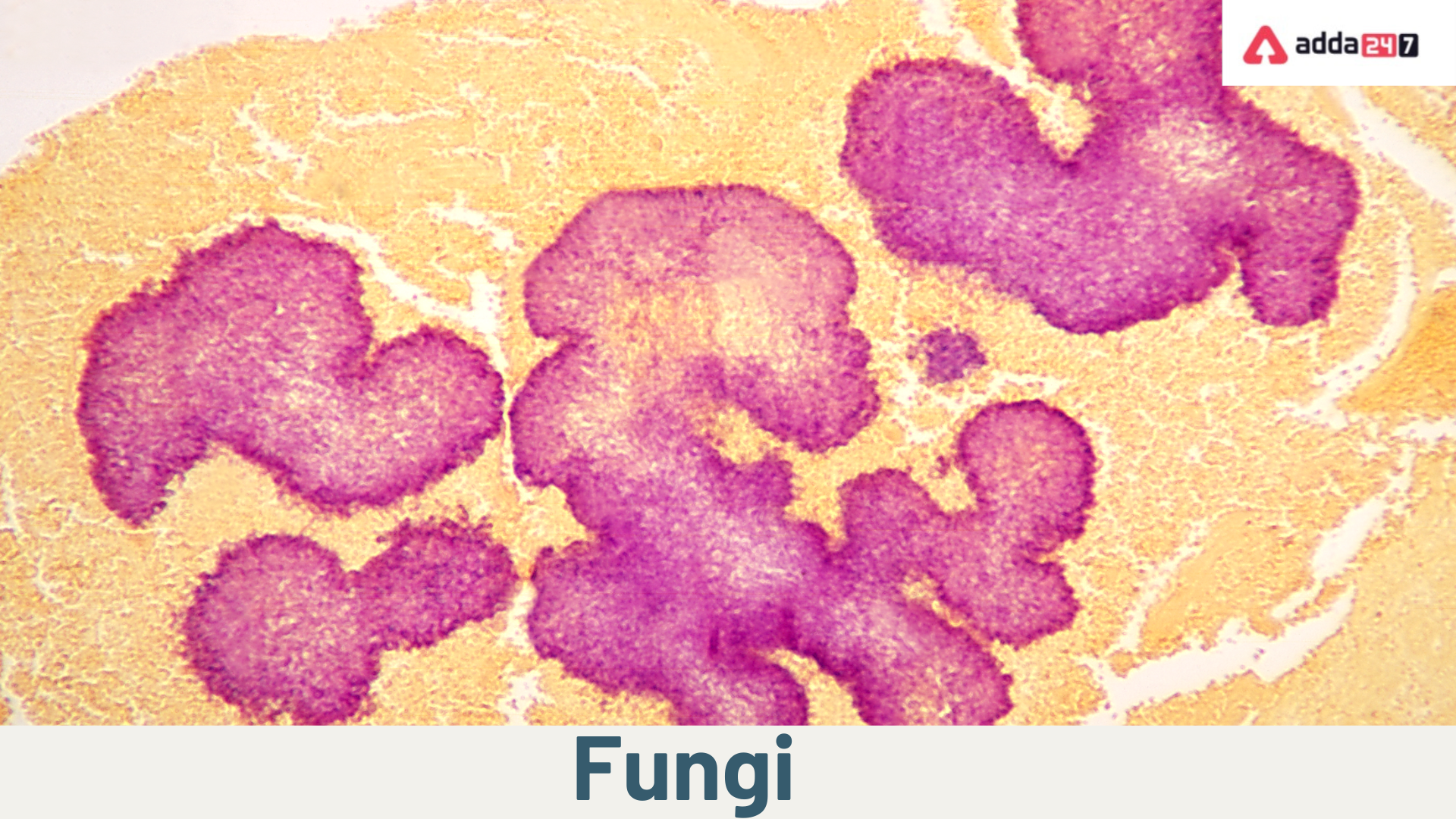What is Fungi?- Definition
Fungi are eukaryotic organisms that include microorganisms such as yeasts, moulds and mushrooms. These organisms are classified under kingdom fungi.
The organisms found in Kingdom fungi contain a cell wall and are omnipresent. They are classified as heterotrophs among the living organisms.
To name a few – the appearance of black spots on bread left outside for some days, the mushrooms and the yeast cells, which are commonly used for the production of beer and bread are also fungi. They are also found in most skin infections and other fungal diseases.
If we observe carefully, all the examples that we cited involve moist conditions. Thus, we can say that fungi usually grow in places which are moist and warm enough to support them.
What is Fungi?- Structure Made up of
The structure of fungi can be explained in the following points:
- Almost all the fungi have a filamentous structure except the yeast cells.
- They can be either single-celled or multicellular organisms.
- Fungi consist of long thread-like structures known as hyphae. These hyphae together form a mesh-like structure called mycelium.
- Fungi possess a cell wall which is made up of chitin and polysaccharides.
- The cell wall comprises a protoplast, which is differentiated into other cell parts such as cell membrane, cytoplasm, cell organelles and nuclei.
- The nucleus is dense, clear, with chromatin threads. The nucleus is surrounded by a nuclear membrane.
What is Fungi?- Characteristics in Microbiology
Following are the important characteristics of fungi:
- Fungi are eukaryotic, non-vascular, non-motile and heterotrophic organisms.
- They may be unicellular or filamentous.
- They reproduce by means of spores.
- Fungi exhibit the phenomenon of alternation of generation.
- Fungi lack chlorophyll and hence cannot perform photosynthesis.
- Fungi store their food in the form of starch.
- Biosynthesis of chitin occurs in fungi.
- The nuclei of the fungi are very small.
- The fungi have no embryonic stage. They develop from the spores.
- The mode of reproduction is sexual or asexual.
- Some fungi are parasitic and can infect the host.
- Fungi produce a chemical called pheromone which leads to sexual reproduction in fungi.
- Examples include mushrooms, moulds and yeast.
What is Fungi?- Classification in Microbiology
Kingdom Fungi are classified based on different modes. The different classification of fungi is as follows:
Based on Mode of nutrition
On the basis of nutrition, kingdom fungi can be classified into 3 groups.
- Saprophytic – The fungi obtain their nutrition by feeding on dead organic substances. Examples: Rhizopus, Penicillium and Aspergillus.
- Parasitic – The fungi obtain their nutrition by living on other living organisms (plants or animals) and absorb nutrients from their host. Examples: Taphrina and Puccinia.
- Symbiotic – These fungi live by having an interdependent relationship with other species in which both are mutually benefited. Examples: Lichens and mycorrhiza. Lichens are the symbiotic association between algae and fungi. Here both algae and fungi are mutually benefited as fungi provide shelter for algae and in reverse algae synthesis carbohydrates for fungi. Mycorrhiza is the symbiotic association present between fungi and plants. Fungi improve nutrient uptake by plants, whereas, plants provide organic molecules like sugar to the fungus.
Based on Spore Formation
Kingdom Fungi are classified into the following based on the formation of spores:
- Zygomycetes – These are formed by the fusion of two different cells. The sexual spores are known as zygospores, while the asexual spores are known as sporangiospores. The hyphae are without the septa. Example – Mucor.
- Ascomycetes – They are also called sac fungi. They can be coprophilous, decomposers, parasitic or saprophytic. The sexual spores are called ascospores. Asexual reproduction occurs by conidiospores. Example – Saccharomyces.
- Basidiomycetes – Mushrooms are the most commonly found basidiomycetes and mostly live as parasites. Sexual reproduction occurs by basidiospores. Asexual reproduction occurs by conidia, budding or fragmentation. Example- Agaricus.
- Deuteromycetes – They are otherwise called imperfect fungi as they do not follow the regular reproduction cycle as the other fungi. They do not reproduce sexually. Asexual reproduction occurs by conidia. Example – Trichoderma.
What is Fungi?- Reproduction in Biology
Reproduction in fungi is both by sexual and asexual means. The sexual mode of reproduction is referred to as teleomorph and the asexual mode of reproduction is referred to as anamorph.
Vegetative reproduction in fungi –This takes place by budding, fission and fragmentation.
Asexual reproduction – This takes place with the help of spores called conidia or zoospores, or sporangiospores.
Sexual reproduction – This occurs by ascospores, basidiospores, and oospores.
The conventional mode of sexual reproduction is not always observed in the kingdom Fungi. In some fungi, the fusion of two haploid hyphae does not result in the formation of a diploid cell. In such cases, there appears an intermediate stage called the dikaryophase. This stage is followed by the formation of diploid cells.
What is Fungi?- Examples
Following are the common examples of fungi:
- Yeast
- Mushrooms
- Moulds
- Truffles
What is Fungi in Hindi?
कवक यूकेरियोटिक जीव हैं जिनमें सूक्ष्मजीव जैसे खमीर, मोल्ड और मशरूम शामिल हैं। इन जीवों को किंगडम कवक के अंतर्गत वर्गीकृत किया गया है।
किंगडम कवक में पाए जाने वाले जीवों में एक कोशिका भित्ति होती है और ये सर्वव्यापी होते हैं। उन्हें जीवित जीवों के बीच हेटरोट्रॉफ़ के रूप में वर्गीकृत किया गया है।
कुछ का नाम लेने के लिए – कुछ दिनों के लिए बाहर छोड़ी गई रोटी पर काले धब्बे दिखाई देना, मशरूम और खमीर कोशिकाएं, जो आमतौर पर बीयर और ब्रेड के उत्पादन के लिए उपयोग की जाती हैं, वे भी कवक हैं। वे अधिकांश त्वचा संक्रमण और अन्य कवक रोगों में भी पाए जाते हैं।
यदि हम ध्यान से देखें, तो हमारे द्वारा उद्धृत सभी उदाहरणों में नम स्थितियां शामिल हैं। इस प्रकार, हम कह सकते हैं कि कवक आमतौर पर उन जगहों पर उगते हैं जो नम और गर्म होते हैं ताकि उनका समर्थन किया जा सके।
कवक क्या है?- संरचना किससे बनी होती है?
कवक की संरचना को निम्नलिखित बिंदुओं में समझाया जा सकता है:
खमीर कोशिकाओं को छोड़कर लगभग सभी कवक में एक रेशायुक्त संरचना होती है।
वे या तो एकल-कोशिका वाले या बहुकोशिकीय जीव हो सकते हैं।
कवक में लंबे धागे जैसी संरचनाएं होती हैं जिन्हें हाइपहे के रूप में जाना जाता है। ये हाइपहे मिलकर एक जाली जैसी संरचना बनाते हैं जिसे मायसेलियम कहा जाता है।
कवक में एक कोशिका भित्ति होती है जो काइटिन और पॉलीसेकेराइड से बनी होती है।
कोशिका भित्ति में एक प्रोटोप्लास्ट होता है, जो कोशिका झिल्ली, कोशिका द्रव्य, कोशिका अंग और नाभिक जैसे अन्य कोशिका भागों में विभेदित होता है।
नाभिक घने, स्पष्ट, क्रोमेटिन धागे के साथ होता है। नाभिक एक परमाणु झिल्ली से घिरा होता है।









 CUET History Syllabus 2026 (Updated), Do...
CUET History Syllabus 2026 (Updated), Do...
 CUET General Test Syllabus 2026 (Latest)...
CUET General Test Syllabus 2026 (Latest)...
 CUET Economics Syllabus 2026, Exam Patte...
CUET Economics Syllabus 2026, Exam Patte...














